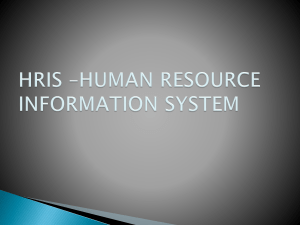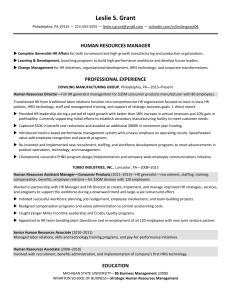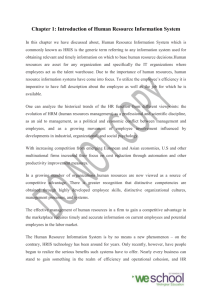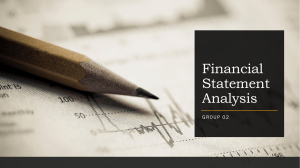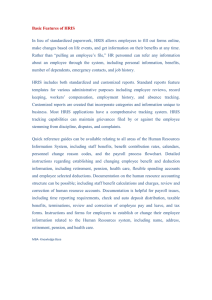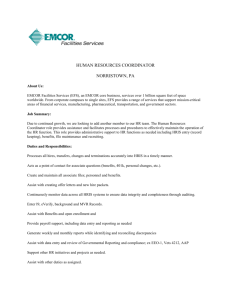Uploaded by
annamaria.amato22
SHRM Data & Analytics Midterm Exam - Practice Questions
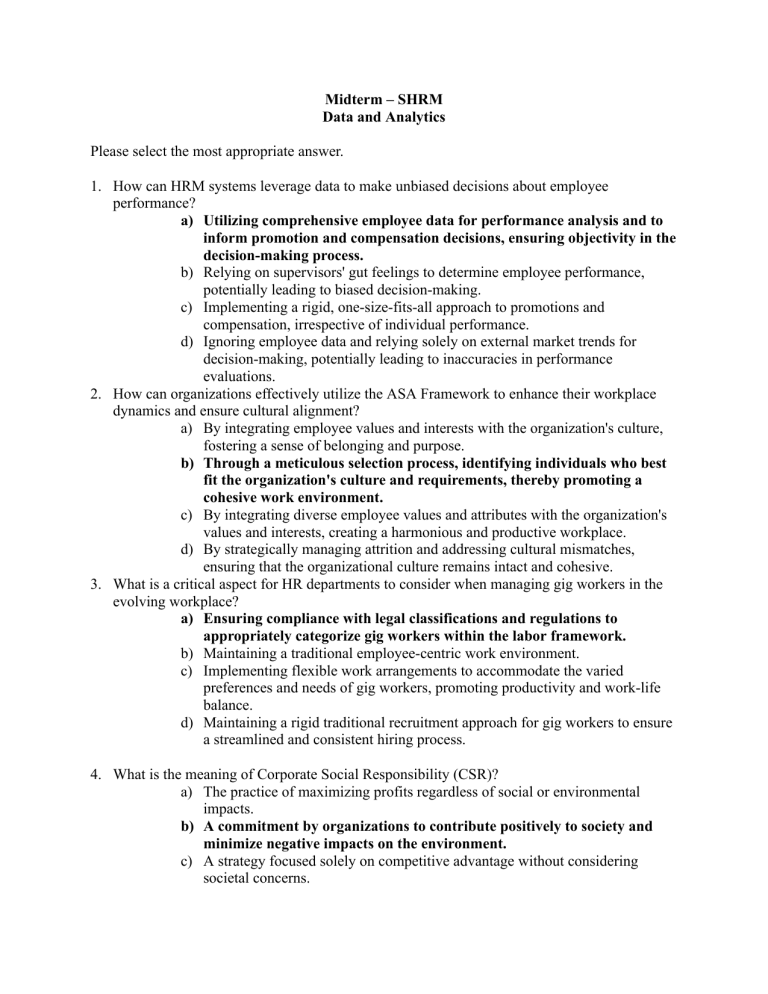
Midterm – SHRM Data and Analytics Please select the most appropriate answer. 1. How can HRM systems leverage data to make unbiased decisions about employee performance? a) Utilizing comprehensive employee data for performance analysis and to inform promotion and compensation decisions, ensuring objectivity in the decision-making process. b) Relying on supervisors' gut feelings to determine employee performance, potentially leading to biased decision-making. c) Implementing a rigid, one-size-fits-all approach to promotions and compensation, irrespective of individual performance. d) Ignoring employee data and relying solely on external market trends for decision-making, potentially leading to inaccuracies in performance evaluations. 2. How can organizations effectively utilize the ASA Framework to enhance their workplace dynamics and ensure cultural alignment? a) By integrating employee values and interests with the organization's culture, fostering a sense of belonging and purpose. b) Through a meticulous selection process, identifying individuals who best fit the organization's culture and requirements, thereby promoting a cohesive work environment. c) By integrating diverse employee values and attributes with the organization's values and interests, creating a harmonious and productive workplace. d) By strategically managing attrition and addressing cultural mismatches, ensuring that the organizational culture remains intact and cohesive. 3. What is a critical aspect for HR departments to consider when managing gig workers in the evolving workplace? a) Ensuring compliance with legal classifications and regulations to appropriately categorize gig workers within the labor framework. b) Maintaining a traditional employee-centric work environment. c) Implementing flexible work arrangements to accommodate the varied preferences and needs of gig workers, promoting productivity and work-life balance. d) Maintaining a rigid traditional recruitment approach for gig workers to ensure a streamlined and consistent hiring process. 4. What is the meaning of Corporate Social Responsibility (CSR)? a) The practice of maximizing profits regardless of social or environmental impacts. b) A commitment by organizations to contribute positively to society and minimize negative impacts on the environment. c) A strategy focused solely on competitive advantage without considering societal concerns. 5. 6. 7. 8. d) The pursuit of short-term financial gains at the expense of long-term sustainability. What is the primary characteristic of anchoring bias in decision-making processes? a) Placing excessive emphasis on the initial piece of information encountered, even if it's irrelevant or unrelated to the decision at hand. b) Relying on recent and readily available information to make decisions without considering historical data or long-term trends. c) Giving undue importance to the opinions of influential individuals or authority figures, regardless of the validity of their arguments. d) Overlooking potential risks and uncertainties associated with a decision due to an overestimation of one's own capabilities and knowledge. How might availability bias impact the decision-making process in a business setting? a) Overlooking historical data and market trends when making investment decisions, leading to potential missed opportunities and suboptimal returns on investment. b) Giving undue weight to the opinions of high-ranking executives when developing business strategies, potentially limiting innovation and stifling diverse perspectives within the organization. c) Placing excessive importance on the first impression of a potential client during a sales pitch, regardless of the subsequent negotiations and contractual terms, potentially leading to skewed client relations and unrealistic expectations. d) Leading to the overestimation of the occurrence of specific risks due to their recent prominence in the media, resulting in a skewed perception of the actual likelihood of these risks. Which type of organizational culture fosters a family-like environment where employees have a strong sense of belonging, mentorship is valued, and teamwork is emphasized, promoting a shared commitment to the organization's mission and values? a) Clan Culture b) Adhocracy Culture c) Market Culture d) Hierarchy Culture Which strategy does Canada primarily rely on to reinforce its labor force, considering the impact of changing demographics and the need for skilled workers? a) Implementing policies to encourage domestic workforce growth and limit international recruitment efforts, prioritizing the employment of local residents. b) Strengthening collaboration with neighboring countries to share workforce resources and establish cross-border employment opportunities, reducing reliance on external talent. c) Enhancing immigration programs and initiatives to attract global talent, supplementing the domestic labor force with skilled professionals from diverse international backgrounds. d) Implementing trade restrictions and reducing cross-border partnerships, limiting opportunities for collaboration and talent exchange in the labor market. 9. What is one of the potential risks associated with excessive reliance on prescriptive analytics in decision-making processes? a) Legal compliance issues b) Unreliable data inputs c) Loss of human judgment d) Enhanced efficiency and productivity 10. What is the primary purpose of salary benchmarking in an organization? a) Analyzing market trends and consumer behavior to inform product development and marketing strategies. b) Identifying key areas for cost reduction and optimizing budget allocation to ensure financial stability. c) Comparing employee salaries with industry standards and market rates to ensure competitive compensation packages. d) Conducting performance appraisals and setting targets to measure employee productivity and job performance. 11. In a company, an analysis indicates that as the number of hours spent on employee training increases, there is a noticeable improvement in the overall sales performance. What type of correlation does this scenario most likely illustrate? a) Positive correlation b) Negative correlation c) No correlation d) Inverse correlation 12. In a manufacturing company, it is observed that as the level of employee training and skill development increases, the rate of product defects decreases significantly. What does this scenario imply about the relationship between employee training and product quality? a) The correlation is strong and positive, close to 1. b) The correlation is weak and negative, close to -1. c) There is no significant relationship between employee training and product quality, with the correlation close to 0. d) The correlation is moderate and positive, slightly above 0.5. 13. A retail chain, aiming to streamline its supply chain management and inventory control processes, utilizes prescriptive analytics to generate real-time recommendations on optimal stock levels, delivery schedules, and product assortments across various store locations, thereby maximizing operational efficiency and reducing overhead costs. What is the primary goal of applying prescriptive analytics in this scenario? a) Identifying consumer preferences and market trends to introduce innovative products and enhance customer engagement, driving sales growth and market expansion. b) Analyzing employee performance and workflow patterns to implement effective training programs and operational strategies, fostering a productive and motivated workforce. c) Optimizing business operations and resource allocation to ensure cost-effective management and strategic utilization of company assets, improving overall profitability and financial stability. d) Utilizing data-driven insights and algorithmic recommendations to make informed decisions and take proactive actions that improve process efficiency and maximize operational performance within the retail supply chain. 14. What fundamental principle underlies the scientific process, emphasizing the need for systematic and evidence-based problem-solving methods? a) The recognition that knowledge is obtained through intuitive understanding and personal experience. b) The emphasis on speculation and conjecture as the primary drivers of problem-solving and inquiry. c) The reliance on tradition and authority as the primary sources of knowledge acquisition and problem resolution. d) The assertion that knowledge is derived from evidence and data, necessitating a systematic and rigorous approach to problem-solving and inquiry. 15. If the mission of a company is to provide high-quality, sustainable, and affordable technology solutions that empower businesses and individuals to achieve their full potential. What might be the vision? a) Integrity, Respect, and Innovation b) To value teamwork and collaboration in all our projects. c) To be a global leader in technological advancement, driving innovation and positive change in the industry while maintaining a strong commitment to ethical business practices and social responsibility. d) To meet the needs of our customers through excellent customer service. 16. Emerging markets, changing consumer preferences, and technological advancements would be examples of which element of the SWOT analysis? a) Strengths b) Weaknesses c) Opportunities d) Threats 17. A retail chain adopts a cost leadership strategy. How might the company effectively execute this strategy to maintain its position? a) Investing in cutting-edge technologies and premium product features to appeal to a niche market segment and maintain higher profit margins. b) Implementing supply chain optimization and operational efficiency measures. c) Emphasizing aggressive marketing campaigns and premium branding initiatives to establish a reputation for superior product quality and value-added services. d) Focusing on diversification and product differentiation to cater to a wider range of customer preferences and capture market share through unique product offerings. 18. What is the primary purpose of a balanced scorecard in organizational management? a) Ensuring compliance with industry standards and regulatory requirements to maintain operational transparency and accountability. b) Facilitating effective communication between different departments and stakeholders to promote a collaborative and unified approach to business operations. c) Providing a comprehensive framework for measuring and monitoring the organization's performance across various key areas, aligning strategic goals with operational activities. d) Streamlining budgetary planning and resource allocation processes to optimize cost efficiency and financial performance, ensuring sustainable growth and profitability. 19. What does contextual alignment primarily focus on in the realm of HRM? a) Implementing standardized HR policies and procedures to streamline organizational operations and ensure uniformity across different departments. b) Customizing employee training programs and professional development initiatives to meet individual skill requirements and promote career advancement opportunities. c) Aligning HR practices with the unique needs, goals, and cultural circumstance of the organization, facilitating a cohesive and integrated approach to workforce management. d) Developing comprehensive compensation and benefits packages to attract and retain top talent, ensuring employee satisfaction and long-term commitment to the organization. 20. What are the fundamental components that constitute a comprehensive hypothesis when formulating a research question? a) Statement, variables, directionality b) Observation, analysis, results c) Abstract, experiment, conclusions d) Statement, magnitude, correlation 21. What is a fundamental distinction between quantitative and qualitative data in research methodology? a) The level of subjectivity involved in data interpretation and analysis. b) The source of data collection, whether from primary or secondary sources. c) The manner in which data is presented and visualized, either through tables and charts or textual descriptions. d) The type of information obtained, either numerical and measurable data or descriptive and non-numerical data. 22. What is the primary purpose of utilizing T-tests in statistical analysis? a) To identify correlations and relationships between variables within a dataset. b) B) To determine the presence of outliers and anomalies that might affect overall data trends. c) To compare means of two groups and assess whether there exists a statistically significant difference between them. d) To establish causality and predict future trends based on historical data patterns. 23. In which of the following work-related scenarios would the application of regression analysis be most suitable? a) Analyzing the relationship between employee training hours and project completion times to optimize workforce productivity and project management strategies. b) Evaluating office supply expenses and utility costs to streamline budget allocation and expenditure management within a corporate environment. c) Examining staff turnover rates and employee engagement survey results to enhance retention strategies and foster a positive work environment in a company. d) Assessing customer service response times and call volume data to improve service efficiency and customer satisfaction in a call center setting. 24. What does the term 'standard deviation' represent in statistical analysis, with regard to a group of numeric values? a) The highest value in the dataset, indicative of the data spread. b) The middle value in the dataset, providing a measure of central tendency. c) The amount of variation of the data points around their mean, representing the extent of dispersion in the dataset. d) The frequency of occurrence of each distinct value in the dataset, highlighting the distribution pattern of the data. 25. What is the initial step in HR Analytics and the Scientific Process? a) Collecting relevant data sources for analysis b) Formulating a hypothesis for testing c) Identifying the problem to be addressed or investigated d) Analyzing historical trends and patterns in the available data 26. What is the primary function of a pie chart? a) Comparing individual data points and their frequencies across different categories. b) Identifying potential correlations and relationships between two or more variables. c) Showcasing the distribution pattern and frequency of data points within a dataset. d) Representing the relative sizes of different categories as a part of the whole data set. 27. What distinguishes continuous variables from categorical variables in data analysis? a) Continuous variables involve numerical data that can be measured across a continuous range, while categorical variables represent distinct groups or categories. b) Continuous variables display data in discrete groups or categories, whereas categorical variables represent data points on a continuous scale. c) Continuous variables demonstrate trends and patterns within a dataset, while categorical variables help identify outliers and anomalies in the data. d) Continuous variables are used for comparing means and medians within a dataset, whereas categorical variables aid in understanding the distribution of data points. 28. How has the expansion of businesses globally impacted HR strategies, emphasizing the need for effective talent management and diversity initiatives in the international workforce? a) Shifting the focus towards standardization of HR policies and procedures across different organizational units. b) Emphasizing the importance of local market adaptation and tailored HR practices to meet diverse cultural and regional needs. c) Streamlining administrative tasks and payroll functions to ensure consistency and compliance across various global operations. d) Prioritizing workforce automation and technological integration to manage cross-border HR activities and employee data. 29. What defines 'little data,' characterized by its manageable size, organized structure, and predefined collection purposes? a) Large-scale datasets collected from various sources, requiring complex storage and management systems for analysis. b) Unstructured data obtained in significant volumes, often necessitating advanced analytical techniques for data organization and interpretation. c) Well-organized, small-scale datasets tailored for specific objectives, easily manageable in conventional databases, and able to be placed in rows and columns. d) Comprehensive datasets gathered from diverse sources with no predetermined objectives, requiring specialized tools for data structuring and analysis. 30. Which of the following is NOT typically considered a challenge for HRIS (Human Resource Information System)? a) Cost b) Traditional HR skill set c) Lost data d) Data privacy concerns 31. What is the primary function of a data lake? a) Data Storge: Aggregates data from multiple sources into a centralized storage system for simplified access and analysis. b) Data Cleansing: Processes and cleans raw data to ensure consistency and accuracy before integration into the data lake. c) Data Standardization: Converts raw data into a standardized format for better organization and accessibility within the data lake. d) Data Encryption: Implements advanced security measures to protect sensitive information stored within the data lake from unauthorized access. 32. What do scraping and crawling tools primarily refer to in the context of data extraction and retrieval? a) Software applications used to collect, organize, and analyze data from various databases and cloud storage systems. b) Programs designed to identify potential vulnerabilities and security loopholes within a company's network infrastructure. c) Tools utilized for creating and maintaining digital content, including websites, social media posts, and multimedia resources. d) Programs designed to scour and pull data from websites and other electronic sources in a systematic manner. 33. Among the listed functions of managing people data in an HRIS, which one does it NOT typically entail? a) Centralization: HRIS consolidates all employee data into a single, secure database. b) Data Accuracy: Ensures accuracy and consistency by introducing manual entry errors for data updates. c) Data Security: Provides robust security measures to protect sensitive personnel information. d) Automation: Introduces complex manual processes for data entry, updates, and retrieval within the HRIS. 35. What is the primary aim of storytelling with data, emphasizing simplicity and ease of interpretation for the audience? a) Presenting raw data in its complex form to showcase the intricacies of the information. b) Utilizing sophisticated data formats that might overwhelm the audience during the presentation. c) Emphasizing the importance of maintaining complex data sets without any simplification. d) Communicating data in a manner that brings it to life for the audience, making it more understandable through data visualizations and simplified presentations. 36. What does logical design primarily involve in the context of business requirements and data processing? a) Implementing business requirements directly without any translation or modification. b) Complicating business processes by introducing convoluted data flow diagrams. c) The translation of business requirements into improved business processes, often depicted through data flow diagrams showcasing how data move within an information system. d) Integrating business processes without any consideration for data processing requirements. 37. According to Kurt Lewin's change theory, what is a key focus during the 'Refreeze' stage of the change process? a) Implementing new policies and procedures to align with the updated organizational structure. b) Monitoring employee productivity without reinforcing the use of the new systems and processes. c) Reinforcing the importance of maintaining the status quo and resisting any further change initiatives. d) Solidifying the changes by integrating them into the organization's culture and operational practices. 38. What role does a key variable typically play in the context of constructing relationships between tables and merging data from different tables? a) Storing irrelevant information not associated with any specific record, leading to data redundancy. b) Serving as a general placeholder for data across different tables without establishing any clear connections or relationships. c) Providing the necessary information to construct relationships between tables and merge data from different tables, often represented by a unique identifier associated with each record. d) Creating inconsistencies in data management by introducing multiple variables with similar properties but different identifiers. 39. What does the term 'query' primarily refer to within the context of a database? a) Storing miscellaneous data within the database, often without any specific purpose or goal in mind. b) A question or a request for information posed to a database c) A unique identifier associated with each record. d) Creating inconsistencies in data management by introducing various requests for information without any specific purpose or direction. 40. What are one of the distinguishing characteristics of Traditional Tiered Architecture and Cloud-Based Architecture for HRIS solutions? a) Traditional Tiered Architecture relies on the establishment of on-premises infrastructure, including physical servers and networking equipment, whereas Cloud-Based Architecture utilizes virtualized resources provided by third-party service providers, enabling access over the internet without the need for physical infrastructure maintenance. b) Traditional Tiered Architecture involves reduced upfront capital expenditures and minimizes the need for in-house IT management, whereas Cloud-Based Architecture requires on-premises hardware and infrastructure for hosting HRIS software and databases. c) Traditional Tiered Architecture has limited data security, whereas Cloud-Based Architecture ensures enhanced three-tiered data security, allowing organizations to modify its needs as per HR requirements and business growth. d) Cloud-Based Architecture provides limited accessibility and remote connectivity, hindering HR professionals and employees from accessing HRIS data and applications from certain locations, whereas Traditional Tiered Architecture supports comprehensive accessibility and remote connectivity options. 42. What is the significance of Data Cleaning in the context of HRIS systems? a) Data Cleaning involves the process of manipulating data to fit specific formats required for analysis, enabling organizations to conduct comprehensive data evaluations for strategic decision-making. b) Data Cleaning is the back-end coding to create a comprehensive database that serves as a valuable resource for descriptive and predictive analyses. c) Data Cleaning fosters the development of a robust and reliable data repository that enhances the HRIS system's functionality, providing accurate and relevant information for strategic workforce planning and talent management. d) Data Cleaning primarily focuses on the extraction of specific data subsets for detailed analysis, enabling HR professionals to create customized reports for various stakeholders, facilitating efficient communication and decision-making processes. 43. “Conduct market research and analysis to identify new opportunities and consumer trends” And “Collaborate with the sales team to ensure alignment with marketing initiatives and maximize lead generation efforts” might be two items within which part of the job analysis? a) Job specifications b) Job modelling c) Job description d) Job subject matter experts 44. In job analysis, the term "tasks" refers to: a) Detailed information about the working conditions and environment for a particular job. b) The required qualifications and skills necessary for successful job performance. c) The specific activities, duties, and responsibilities that constitute the core functions of the job. d) An evaluation of the salary range associated with the job position. 45. Competency modeling in job analysis primarily aims to: a) Identify the fundamental values and mission of an organization. b) Understand the essential attributes and behaviors necessary for a group of jobs or across an entire organization. c) Determine the salary structure based on different skill levels. d) Analyze the external market trends impacting the organization's workforce. 46. What is NOT one of the strategies for collecting job analysis data? a) Year over year compensation analysis b) Interviews c) Questionnaires d) Observations 47. An organization is undergoing a reevaluation of its hiring practices and job performance criteria. As part of this initiative, it conducts a comprehensive analysis of the tasks involved in various roles and identifies the knowledge, skills, abilities, and other characteristics necessary for effective job performance within these roles. The HR team utilizes this information to refine job descriptions, develop training programs, and create a competency framework that aligns with the organization's goals and values. Which of the following processes does the scenario best exemplify? a) Task-KSAO job analysis b) Work flow analysis c) Organizational restructuring d) Competency modelling 48. A technique that entails requesting subject matter experts (SMEs) to delineate significant job situations that they commonly face in their work for the purpose of job analysis is called: a) Task-KSAO job analysis b) Critical incidents technique c) Competency modelling d) Work flow analysis 49. What type of job analysis involves the utilization of a standardized questionnaire to gather detailed information about the nature of various job roles, including their tasks and corresponding descriptions? a) Task-KSAO job analysis b) Critical incidents technique c) Competency modeling d) Position Analysis Questionnaire (PAQ) 50. In a manufacturing firm, the assembly line workers are increasingly disengaged due to the repetitive nature of their tasks. The management decides to introduce changes to the employees' roles to enhance their job satisfaction and motivation. Which of the following would be considered job enlargement? a) The company organizes a team-building workshop to foster better communication among employees. b) The management implements a new employee recognition program to acknowledge outstanding performance. c) The assembly line workers are assigned additional tasks related to quality control checks and minor equipment maintenance. d) The firm arranges a leadership development program for supervisors to improve their managerial skills. 51. In a fast-paced consulting firm, employees are frequently confronted with tight deadlines and numerous client demands. As a result, the workforce experiences heightened stress levels, leading to decreased job satisfaction and motivation.What intervention aligns with the principles of the Job Demands-Control Model (JDC) and can help mitigate the negative effects of stress in the workplace? a) Offering employees decision-making authority and autonomy in managing their work tasks and responsibilities. b) Providing flexible work hours and remote work options for employees to manage their time effectively. c) Implementing a comprehensive wellness program focused on physical fitness and mental health support. d) Assigning additional tasks to employees to broaden their skill sets and enhance their job satisfaction. 52. An employee modifies their tasks to include more creative elements, such as designing new marketing materials or exploring innovative strategies to enhance customer engagement. This proactive approach allows them to redefining their role on their own accord to make it more fulfilling and engaging. Which of the following concepts aligns with these examples? a) Job rotation b) Job enrichment c) Job redesign d) Job crafting 53. Which of the following choices characterizes the significance of subject matter experts (SMEs) in the job analysis process as a potential organizational intervention? a) SMEs act as intermediaries between management and employees, facilitating effective communication within the organization. b) SMEs contribute to fostering a positive work environment by providing valuable insights and recommendations for employee development. c) SMEs aid in promoting employee engagement and participation in decision-making, enhancing morale and job satisfaction. d) SMEs play a crucial role in ensuring the accuracy and relevance of job-related information, supporting informed organizational decision-making and strategy development. 54. Which element of the job characteristics model refers to the use of different skills and abilities within a job, promoting employee engagement and skill development. a) Task identification b) Skill variety c) Feedback d) Autonomy 55. Which of the following best encapsulates the primary tenet of the Job Demands-Resources (JD-R) Model in the context of workplace well-being and performance? a) The JD-R Model emphasizes the importance of balancing job demands and resources to mitigate workplace stress and foster employee engagement. b) The JD-R Model highlights the necessity of minimizing job resources to create a more challenging work environment and encourage employee growth. c) The JD-R Model underscores the need for high job demands to ensure employees remain motivated and perform at optimal levels consistently. d) The JD-R Model advocates for a focus on maximizing job demands while providing minimal job resources to foster a competitive and dynamic work culture.
